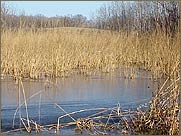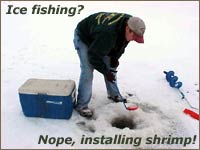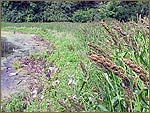|
- Site review and assessment
- Program application,
income and cost share opportunities
- Planning, design and
survey (water level is critical!)
- Implementation, construction
and seeding
- Pool level management
and assessment
- Pool level management
- Waterfowl Food
Plots - Sago, Celery, Wild Rice, Freshwater Shrimp...
it's the food that attracts the ducks!
Just having water alone is not always enough to attract
and hold waterfowl to your site. Ducks like water...but
they like food even more. Proper pool level management
will constructively manage aquatic vegetation by encouraging
and enhancing native aquatic vegetation and invertebrates.
Stagnant deep waters with high turbidity will not allow
needed sunlight to reach the substrate, therefore not
germinating desirable aquatic plants. With this, the
food chain is broken and invertebrates will also not
have the vegetation to grow and feed on.
 Sago
- "narrow leafed pond weed". Grows well in
shallow waters 10 to 36 inches in depth. Produces a
seed pod that waterfowl go crazy over. Divers and puddlers
will come along ways for a good "sago pond".
Planted in spring just after ice-out. Call for current
pricing and place orders in advance for spring harvest. Sago
- "narrow leafed pond weed". Grows well in
shallow waters 10 to 36 inches in depth. Produces a
seed pod that waterfowl go crazy over. Divers and puddlers
will come along ways for a good "sago pond".
Planted in spring just after ice-out. Call for current
pricing and place orders in advance for spring harvest.
Planting instructions
-
Option 1 - "Mud balls" - Find mud
consistent enough to roll tubers inside of mud ball
and let dry. When dry, simply gently place around
selected installation area. Concern is if the bud
balls should soften or dissolve, the tubers could
come lose and float to the surface where they will
be eaten.
Option 2 - "Nails" - Drive a heavy
enough nail through one or two tubers that will cause
the tuber(s) to sink. Caution is that the pearly white
tubers are still readily seen by waterfowl, muskrats
and beaver and could be targeted for a meal.
Option 3 - "Sand Bags" - Pour a half
a cup of dry sand/gravel in the bottom of a penny
bag (small brown bag like you used to get candy in
at the dime store). Then place 3 to 5 tubers in the
bag and pour an additional half cup of sand/gravel
on top of the tubers. Then put two staples in the
top of the bag to hold...do not fold the bag. Place
these package tubers in a cooler or crate that will
hold the weight of several packages. Gently place
the packages in the water and allow to settle to the
bottom. The bags will take on a rusty brown color
and camouflage it from predators. The sand/gravel
median will greatly increase germination success.
Concern is that this is more labor intensive in preparing
the packages but the extra work is worth the increased
chance of success!
Prefers water depths of 12 to 36 inches with sandy
to muddy bottoms.
Recommended seeding rate
- 1000 tubers/ac.

 Wild
Celery - "ribbon grass". Grows well in
2 to 9 ft. water depths. Produces a sought after tuber.
Divers will agitate the bottom releasing the tubers
which float to the surface. Upon returning the surface,
the tubers are quickly eaten up. Planted in spring just
after ice-out. Call for current pricing and place orders
in advance for spring harvest. Wild
Celery - "ribbon grass". Grows well in
2 to 9 ft. water depths. Produces a sought after tuber.
Divers will agitate the bottom releasing the tubers
which float to the surface. Upon returning the surface,
the tubers are quickly eaten up. Planted in spring just
after ice-out. Call for current pricing and place orders
in advance for spring harvest.
Planting instructions
-
Option 1 - "Mud balls" - Find mud
consistent enough to roll tubers inside of mud ball
and let dry. When dry, simply gently place around
selected installation area. Concern is if the bud
balls should soften or dissolve, the tubers could
come lose and float to the surface where they will
be eaten.
Option 2 - "Nails" - Drive a heavy
enough nail through one or two tubers that will cause
the tuber(s) to sink. Caution is that the pearly white
tubers are still readily seen by waterfowl, muskrats
and beaver and could be targeted for a meal.
Option 3 - "Sand Bags" - Pour a half
a cup of dry sand/gravel in the bottom of a penny
bag (small brown bag like you used to get candy in
at the dime store). Then place 3 to 5 tubers in the
bag and pour an additional half cup of sand/gravel
on top of the tubers. Then put two staples in the
top of the bag to hold...do not fold the bag. Place
these package tubers in a cooler or crate that will
hold the weight of several packages. Gently place
the packages in the water and allow to settle to the
bottom. The bags will take on a rusty brown color
and camouflage it from predators. The sand/gravel
median will greatly increase germination success.
Concern is that this is more labor intensive in preparing
the packages but the extra work is worth the increased
chance of success!
Prefers water depths of 12 to 108 inches with sandy
to muddy bottoms.
Recommended seeding rate
- 1000 tubers/ac.

 Wild
Rice - Grows well in 12 to 48 inches but loses some
germination success after 48 inches. Produces seed heads
that drop in the fall and are highly desired by all
waterfowl species. Planted best in the fall before ice-over
but can be carried over with good success in the spring
after ice-out. Call for current pricing and place orders
in advance for fall harvest. Wild
Rice - Grows well in 12 to 48 inches but loses some
germination success after 48 inches. Produces seed heads
that drop in the fall and are highly desired by all
waterfowl species. Planted best in the fall before ice-over
but can be carried over with good success in the spring
after ice-out. Call for current pricing and place orders
in advance for fall harvest.
Planting instructions
- Simply reach in the bag and throw handfuls of rice
out over the desired seeding area. The rice is shaped
so that is acts like an arrow and self plants itself
into the bottom. * Notice - wild rice is smelly stuff
and it is recommended to wear rubber gloves and old
clothes when planting...it is not rotten, it just
smells that way.
Prefers water depths from 12 to 48 inches with muddy
bottoms. Moving water is not required. We have successfully
established wild rice in ponds that are land locked
and restored wetlands that were in the middle of crop
fields. Wild rice can not tolerate water levels greater
than 36 to 48 inches over several years as well as
turbid waters that receive alot of suspended sediment
as light has to reach the bottom annually to germinate
the seed.
Recommended seeding rate
- 50 lbs./ac.

 Freshwater
Shrimp - "amphipods", "scuds".
Do well in most waters but are susceptible to acidic
waters and high turbidity. Very important and highly
desired food source by waterfowl. Installed January
through March. Call for current pricing and place orders
in January and February while supplies last. Shrimp
are harvested from the wild and supplies are limited...
please order early to secure. Freshwater
Shrimp - "amphipods", "scuds".
Do well in most waters but are susceptible to acidic
waters and high turbidity. Very important and highly
desired food source by waterfowl. Installed January
through March. Call for current pricing and place orders
in January and February while supplies last. Shrimp
are harvested from the wild and supplies are limited...
please order early to secure.
Installation
instructions:
Step 1 - Secure shrimp early! It is only available
January and February and sometimes into March but
it goes quickly and there is only a limited supply
to harvest from the wild. Once harvested, the shrimp
HAVE TO BE INSTALLED WITHIN 24 to 48 HOURS
Step 2 - If you are installing through the
ice, drill a hole with an ice auger. If you are not
installing through the ice, go to Step 3.
Step 3 - Place the bag in the water and open
the top but do not allow water in. Allow the water
in the bag time to acclimate to the temperature of
the water you are installing the shrimp into. This
could take 5 to 10 to 15 minutes...it is better to
be safe. Large differences in water temperature could
shock the shrimp.
Step 4 - Once temperature is close, gently
allow some water into the bag from the pond. Continue
to allow some water in over a 3 to 5 minute period.
This will allow the shrimp to acclimate to the different
water chemistry of the pond to the bag.
Step 5 - Once temperature and water chemistry
are acclimated, gently pour the contents of the bag
into the pond. If you are pouring the contents into
the augured hole, gently push the contents down below
the ice.
 Prefers
clean water. Shrimp are invertebrates...their shells
are made of calcium and they are gill breathers. This
makes them very vulnerable to slight acidity of water
(dissolves the shell) and high turbidity (plugs their
gills). You pond can not have excessive run-off from
adjacent fields, ditches or tile lines as these impacts
will most likely add variables that will kill the
shrimp. Another major concern is drift from spraying
insecticides such as the ones that are sprayed for
soybean aphids and grasshoppers. If this is an issue
or concern, not to worry...call PLM and we can help
you develop a plan that may buffer these variables
and within one or two years you may have the right
opportunity that have shrimp in your water again. Prefers
clean water. Shrimp are invertebrates...their shells
are made of calcium and they are gill breathers. This
makes them very vulnerable to slight acidity of water
(dissolves the shell) and high turbidity (plugs their
gills). You pond can not have excessive run-off from
adjacent fields, ditches or tile lines as these impacts
will most likely add variables that will kill the
shrimp. Another major concern is drift from spraying
insecticides such as the ones that are sprayed for
soybean aphids and grasshoppers. If this is an issue
or concern, not to worry...call PLM and we can help
you develop a plan that may buffer these variables
and within one or two years you may have the right
opportunity that have shrimp in your water again.
Recommended installation
rate - 1 to 2 gal./ac
* Note: there are 20 to 40 thousand shrimp per gallon
and most of these are mated pairs which will reproduce
3 to 4 times during the year producing up to 75 young
per time... that is a lot of shrimp!

 Mallard
Millet - Grows well on mudflats and upland areas.
You can drill it in or simply broadcast over a mudflat
or muddy edge. This is considered an agricultural grain
so check your local baiting laws before you hunt over
this product. Mallard
Millet - Grows well on mudflats and upland areas.
You can drill it in or simply broadcast over a mudflat
or muddy edge. This is considered an agricultural grain
so check your local baiting laws before you hunt over
this product.
Recommended seeding
rate - 10 to 20 lbs./ac. depending on drilling or
broadcasting


|